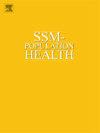美国社会经济弱势患者的居住流动性、社区环境和糖尿病并发症
IF 3.1
2区 医学
Q1 PUBLIC, ENVIRONMENTAL & OCCUPATIONAL HEALTH
引用次数: 0
摘要
住宅流动可以通过改变可用资源、社会支持或医疗保健的连续性来影响健康。本研究旨在了解糖尿病患者的居住流动性和/或社区环境的变化是否与糖尿病相关并发症有关。这项回顾性研究使用了美国110个安全网诊所中19,853名年龄在18-64岁之间的糖尿病患者的电子健康记录数据。广义估计方程逻辑回归模型估计了移动(前后)和社区环境的改变(改善、恶化、相似)是否与慢性糖尿病相关并发症的诊断相关。搬家后与搬家前相比,发生糖尿病相关慢性并发症的概率明显更高(预测概率分别为13.16 vs 6.00),但与周围环境的变化没有关联。那些搬家的人比那些不搬家的人患慢性并发症的可能性更低,这可能是由于搬家前的环境所致。居住流动性在了解糖尿病相关并发症方面发挥着重要作用,而社区环境的变化在接受安全网诊所服务的低收入患者中可能不太重要。运动可能不会直接导致糖尿病相关的慢性并发症,但它可能是其他不稳定因素的一个指标。本文章由计算机程序翻译,如有差异,请以英文原文为准。
Residential mobility, neighborhood environment, and diabetes complications among socioeconomically disadvantaged patients in the United States
Residential mobility can affect health through changes in available resources, social support, or continuity of healthcare. This study sought to understand whether residential mobility and/or change in neighborhood environment among patients with diabetes were associated with diabetes-related complications. This retrospective study used electronic health record data from 19,853 adults aged 18–64 with a diabetes diagnosis seen in 110 safety-net clinics across the United States. Generalized estimating equations logistic regression models estimated whether moving (pre/post) and change in neighborhood environment (improving, worsening, similar) were associated with diagnoses of chronic diabetes-related complications. Post-move versus pre-move was associated with significantly higher probability of diabetes-related chronic complications (predicted probability: 13.16 vs 6.00, respectively), but no association was found by change in neighborhood environment. Those who moved had lower probability of chronic complications than those who did not move which could have been driven by pre-move circumstances among patients who moved. Residential mobility plays an important role in understanding diabetes-related complications while changes in neighborhood environment may be less important among low-income patients served by safety-net clinics. Moving may not be directly responsible for the development of diabetes-related chronic complications, but it may be an indicator for other factors of instability.
求助全文
通过发布文献求助,成功后即可免费获取论文全文。
去求助
来源期刊

Ssm-Population Health
PUBLIC, ENVIRONMENTAL & OCCUPATIONAL HEALTH-
CiteScore
6.50
自引率
2.10%
发文量
298
审稿时长
101 days
期刊介绍:
SSM - Population Health. The new online only, open access, peer reviewed journal in all areas relating Social Science research to population health. SSM - Population Health shares the same Editors-in Chief and general approach to manuscripts as its sister journal, Social Science & Medicine. The journal takes a broad approach to the field especially welcoming interdisciplinary papers from across the Social Sciences and allied areas. SSM - Population Health offers an alternative outlet for work which might not be considered, or is classed as ''out of scope'' elsewhere, and prioritizes fast peer review and publication to the benefit of authors and readers. The journal welcomes all types of paper from traditional primary research articles, replication studies, short communications, methodological studies, instrument validation, opinion pieces, literature reviews, etc. SSM - Population Health also offers the opportunity to publish special issues or sections to reflect current interest and research in topical or developing areas. The journal fully supports authors wanting to present their research in an innovative fashion though the use of multimedia formats.
 求助内容:
求助内容: 应助结果提醒方式:
应助结果提醒方式:


